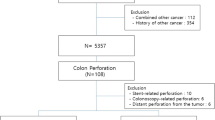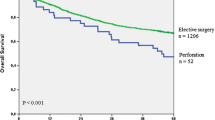Abstract
PURPOSE: Perforation of the colon is seldom associated with malignant disease. Operative mortality varies widely in published studies and little is known about patterns of failure and long-term outcome. An observational study was undertaken to assess the outcome of colorectal cancer complicated by perforation. METHOD: we reviewed a series of 83 consecutive patients treated during a 14-year period at one institution. RESULTS: Fifty-four (65 percent) patients had perforation of the tumor itself, and 29 (35 percent) had diastatic perforation proximal to an obstructing tumor. Twenty-six (31.5 percent) patients had metastatic disease at laparotomy. Primary resection of the diseased segment was performed in 47 (87 percent) patients with perforation of the tumor itself and in 21 (72.4 percent) patients with diastatic perforation proximal to an obstructing tumor. However, only 57 patients (39 (72.2 percent) with perforation of the tumor itself; 18 (62 percent) with diastatic perforation proximal to an obstructing tumor;P=not significant) were potentially cured. Operative mortality was 16.7 and 48.3 percent, respectively (P<0.01) and correlated significantly with Hinchey's stage (P<0.001) and advanced disease (P=0.023). At a mean follow-up of 43 (median 31) months, 21 (46 percent) of the 46 potentially cured survivors were alive. The local recurrence rate was 22.9 percent in patients with perforation of the tumor itself and 18.2 percent in patients with diastatic perforation proximal to an obstructing tumor (P=not significant). Peritoneal seeding occurred in 17 and 0 percent (P=not significant); the mean disease-free interval was 33.9 and 49.9 months (P=not significant); and five-year cumulative disease-related survival probability was 0.51 and 0.90 (P=0.049), respectively. CONCLUSIONS: Diastatic perforation proximal to an obstructing tumor is associated with higher operative mortality and better cancer-related survival than a tumor perforating through the bowel wall. Early diagnosis in diastatic perforation and aggressive management of sepsis associated with radical surgical resection is recommended.
Similar content being viewed by others
References
Goligher JC, Smiddy FG. The treatment of acute obstruction or perforation with carcinoma of the colon and rectum. Br J Surg 1957;45:270–4.
Crowder VH Jr, Cohn I Jr. Perforation in cancer of the colon and rectum. Dis Colon Rectum 1967;10:415–20.
Miller LD, Boruchow IB, Fitts WT Jr. An analysis of 284 patients with perforative carcinoma of the colon. Surg Gynecol Obstet 1966;123:1212–8.
Glenn F, McSherry CK. Obstruction and perforation in colorectal cancer. Ann Surg 1971;173:983–92.
Welch JP, Donaldson GA. Perforative carcinoma of colon and rectum. Ann Surg 1974;180:734–40.
Kelley WE, Brown PW, Lawrence W Jr, Terz JJ. Penetrating, obstructing, and perforating carcinomas of the colon and rectum. Arch Surg 1981;116:381–4.
Umpleby HC, Williamson RC. Survival in acute obstructing colorectal carcinoma. Dis Colon Rectum 1984;27:299–304.
Phillips RK, Hittinger R, Fry JS, Fielding LP. Malignant large bowel obstruction. Br J Surg 1985;72:296–302.
Kane AA, Hammett JE. Diastatic perforation of the cecum. Am J Proctol 1963;14:309–14.
Lichtenstein ME, Myers WH, Dwyer GF. Perforation of the cecum from obstructing carcinoma of the distal colon. Am J Surg 1961;101:26–31.
Breslow N. Covariance analysis of censored survival data. Biometrics 1974;30:89–99.
Hinchey EJ, Schaal PG, Richards GK. Treatment of perforated diverticular disease of the colon. Adv Surg 1987;12:85–109.
Kriwanek S, Armbruster C, Dittrich K, Beckerhinn P. Perforated colorectal cancer. Dis Colon Rectum 1996;39:1409–14.
Mandava N, Kumar S, Pizzi F, Aprile J. Perforated colorectal carcinomas. Am J Surg 1996;172:236–8.
Fielding LP, Phillips RK, Hittinger R. Factors influencing mortality after curative resection for large bowel cancer in elderly patients. Lancet 1989;1:595–7.
Waldron RP, Donovan LA. Mortality in patients with obstructing colorectal cancer. Ann R Coll Surg Engl 1986;68:219–21.
Krukowski ZH, Matheson NA. Emergency surgery for diverticular disease complicated by generalised and faecal peritonitis: a review. Br J Surg 1984;71:921–7.
Matheson NA. Management of obstructed and perforated large bowel carcinoma. Baillieres Clin Gastroenterol 1989;3:6:71–97.
Phillips RK, Hittinger R, Blesovsky L, Fry JS, Fielding LP. Local recurrence following “curative” surgery for large bowel cancer: I. The overall picture. Br J Surg 1984;71:12–6.
Willett C, Tepper JE, Cohen A, Orlow E, Welch C. Obstructive and perforative colonic carcinoma: patterns of failure. J Clin Oncol 1985;3:379–84.
Obrand DI, Gordon PH. Incidence and patterns of recurrence following curative resection for colorectal carcinoma. Dis Colon Rectum 1997;40:15–24.
Umpleby HC, Fermor B, Symes MO, Williamson RC. Viability of exfoliated colorectal carcinoma cells. Br J Surg 1984;74:1049–52.
Fermor B, Umpleby HC, Lever JV, Symes MO, Williamson RC. The proliferative and metastatic potential of exfoliated colorectal carcinoma cells. J Natl Cancer Inst 1984;74:1161–8.
Author information
Authors and Affiliations
Additional information
Read at the Tripartite Meeting, London, United Kingdom, July 8 to 10, 1996.
About this article
Cite this article
Setti Carraro, P.G., Segala, M., Orlotti, C. et al. Outcome of large-bowel perforation in patients with colorectal cancer. Dis Colon Rectum 41, 1421–1426 (1998). https://doi.org/10.1007/BF02237060
Issue Date:
DOI: https://doi.org/10.1007/BF02237060




